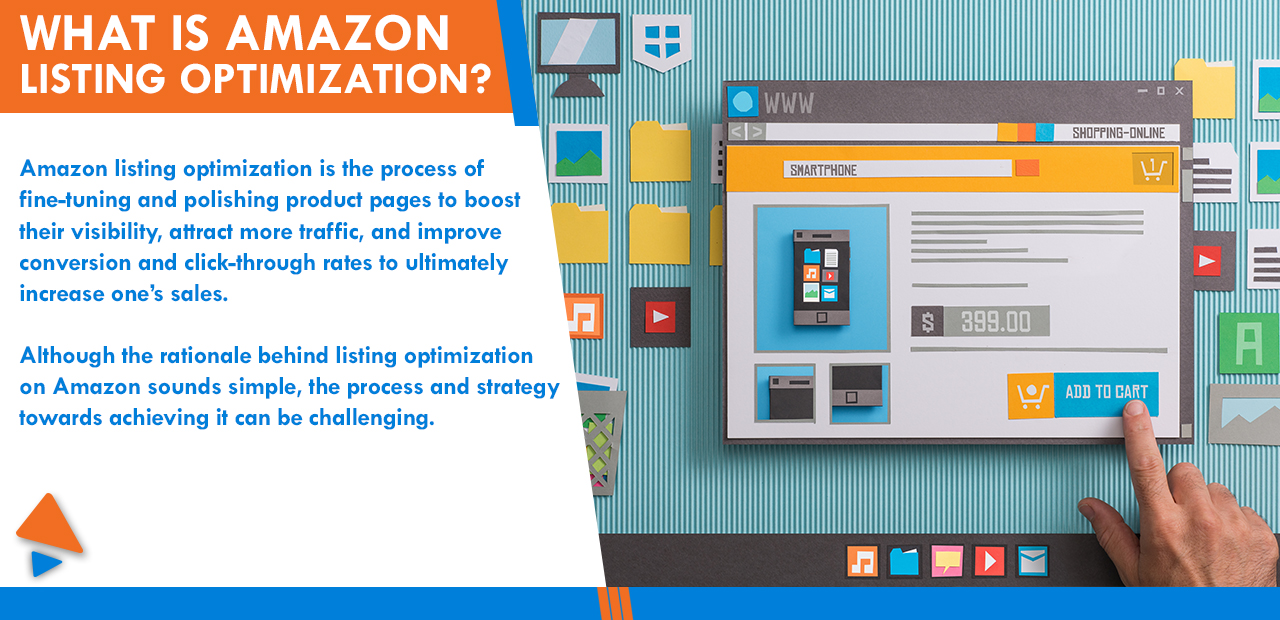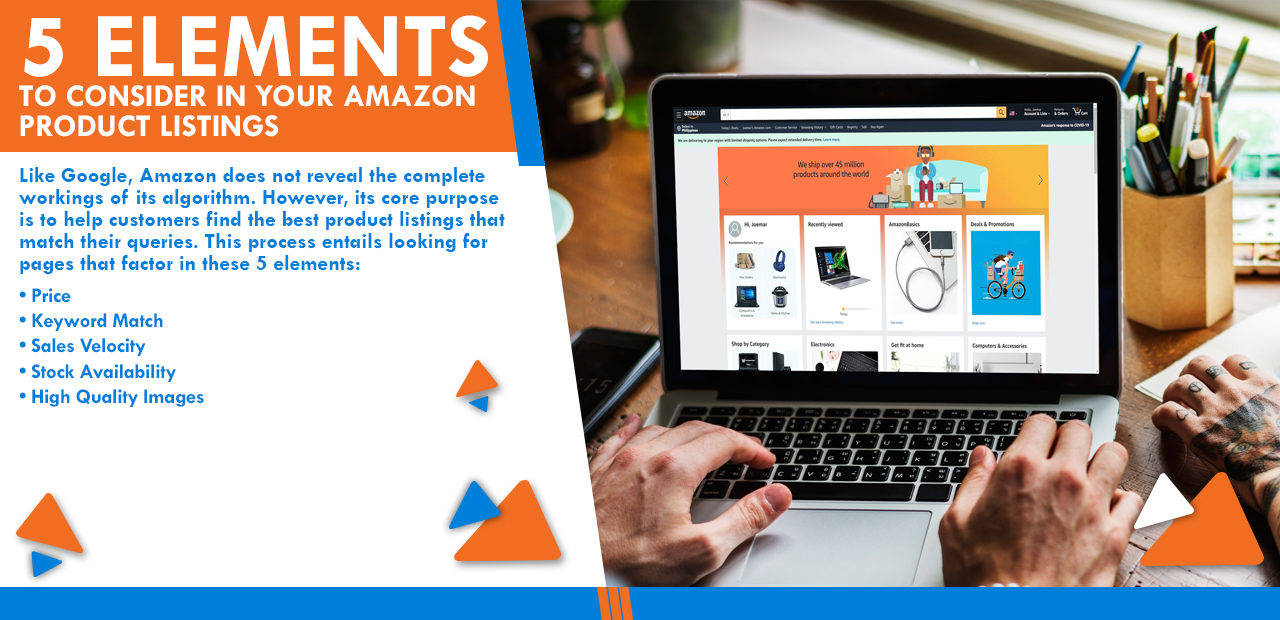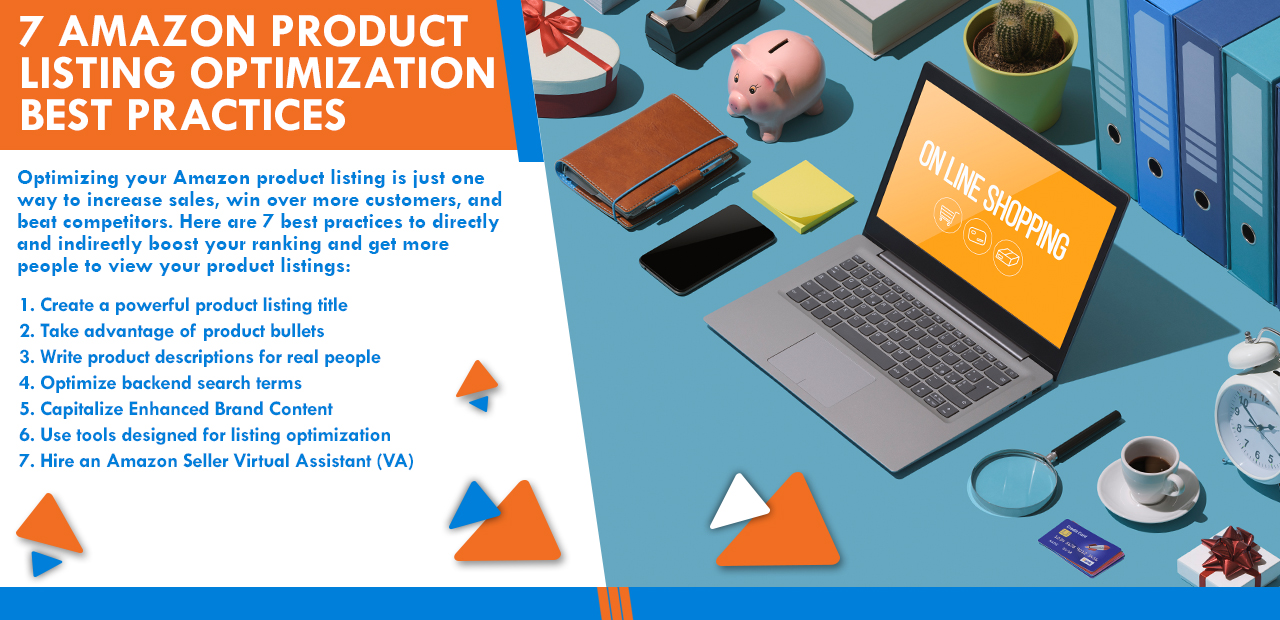A Beginner’s Guide to Amazon Listing Optimization
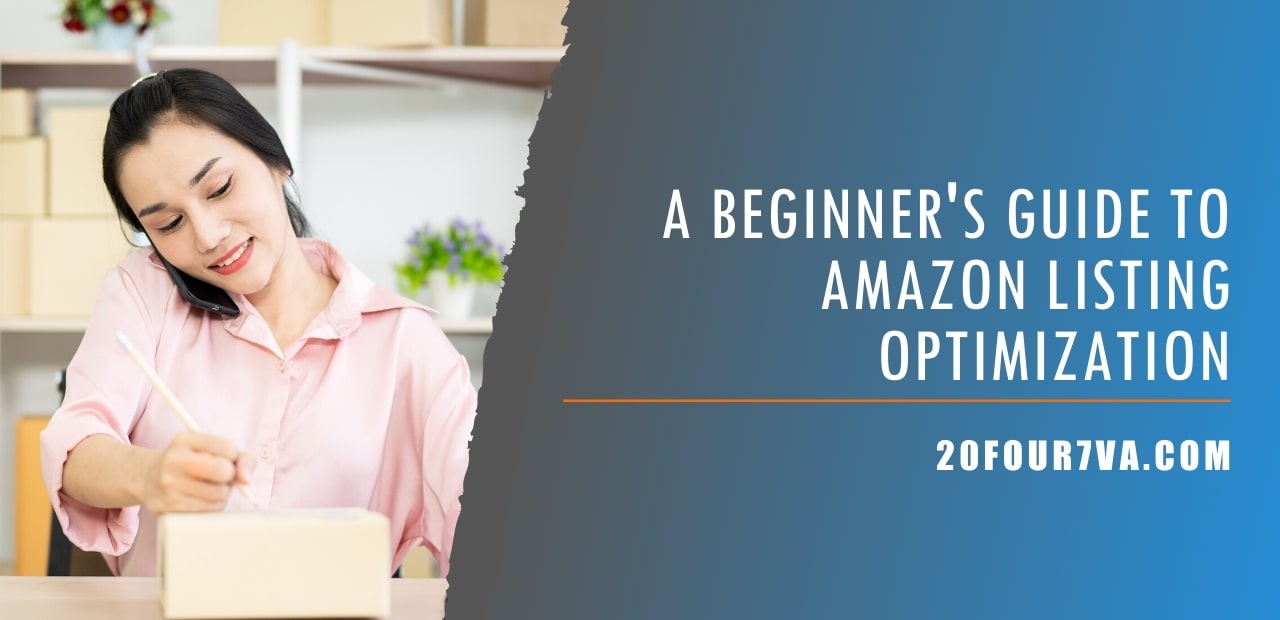
Table of Contents
What is Amazon Listing Optimization?
Understanding Amazon’s A9 Algorithm
Elements to Consider in Your Amazon Product Listing
Amazon Product Listing Optimization Best Practices
Few platforms have made waves as huge and significant in eCommerce as Amazon. Starting out as an online bookstore, the company has come a long way and is now a leader in online shopping. Amazon’s vast seller count and their reputation for quick shipping made it popular among shoppers. However, stiff competition among Amazon vendors has made it a tricky place to navigate — especially for sellers with limited experience and skills in Amazon selling and marketing. To succeed on Amazon, you need to revamp your Amazon listing optimization plan.
What is Amazon Listing Optimization?
Amazon listing optimization is the process of fine-tuning and polishing product pages to boost their visibility, attract more traffic, and improve conversion and click-through rates to ultimately increase one’s sales.
Although the rationale behind listing optimization on Amazon sounds simple, the process and strategy towards achieving it can be challenging.
For one thing, you need to plan around Amazon’s algorithm to boost your visibility on the platform. For another, you have to consider that you are up against dozens of competitors. You’re vying for the attention of consumers who can easily and quickly scroll down their screens to view similar (and sometimes cheaper) deals as yours.
The good news is, you don’t have to leave your product listings to guesswork. Just as you fine-tune and improve your website or blog by strategically placing keywords in your content, there are also ways to tweak your listing format and revamp your overall selling strategy. Doing this allows you to take advantage of Amazon’s algorithm and pull more shoppers onto your page.
Understanding Amazon’s A9 Algorithm
Like Google, Amazon has its own system for ranking search results in its platform. Known as the Amazon A9 algorithm, this set of rules scans and evaluates all data in the wide Amazon marketplace to determine which pages or product listings are the most suitable matches to a buyer’s search queries.
In its heart, Amazon’s A9 algorithm is closely similar to Google in that its ultimate goal is to help users zero in on the best answers to their searches or questions.
So, if you want your product listings to rank high in Amazon’s search results and be the first ones that buyers click, you have to play by the rules of Amazon’s algorithm.
5 Elements to Consider in Your Amazon Product Listings
Like Google, Amazon does not reveal the complete workings of its algorithm. However, its core purpose is to help customers find the best product listings that match their queries. This process entails looking for pages that factor in these 5 elements:
-
Keyword Match
55% of consumers go straight to Amazon to search for items to buy. People are bypassing search engines and are using Amazon directly to look for items they are interested to purchase. When users key in terms or phrases in the marketplace, Amazon will scour its database for pages with the most appropriate text match relevance and rank those pages higher in its search results.
-
High Quality Images
As convenient as online shopping is, it still deprives the customer from physically checking out a product. Sellers make up for it by uploading high-definition photos that feature a product in different angles or focus. Amazon recognizes this importance and recommends images to have at least 1280 pixels. You can boost yours by uploading photos with 2560 pixels or higher and photos with 3D rendering.
-
Stock Availability
Finding the product you were looking for and learning that it was out of stock can be really disappointing. No wonder Amazon doesn’t prioritize Out of Stock listings in its search results! If you want to rank higher, make sure that your product inventory is always up to date.
-
Price
One of the first things that customers check out in a product is its price. Amazon is designed to present similar products together so shoppers can quickly compare them. That’s why you need to make sure that your product rate is not only displayed but also appropriate.
-
Sales Velocity
In Amazon, sales velocity equates to the number and dollar amount of a vendor’s transactions at a given month. In other words, sales velocity is a measurement of how fast you are making money. The more sales you make, the higher you rank in Amazon’s search results pages.
7 Amazon Listing Guidelines
Amazon product listing optimization is just one way to increase sales, win over more customers, and beat competitors. Here are 7 best practices to directly and indirectly boost your ranking and get more people to view your product listings:
1. Create a powerful product listing title.
Your product title is the most valuable factor in your listing. You can have the best product quality and most competitive price but if your product title is generic and forgettable, people will just scroll over your listing. Amazon limits a product title into 250 characters and suggests that it should contain the following:
-
- Brand Name
- Product Line
- Product Type
- Key features and/or materials
- Size
- Color
- Quantity or packaging
Although Amazon suggests to add these elements, it doesn’t mean you should pack your title with all these key terms. It is how you order these elements that will make your listing stand out. Remember to put the most relevant keywords first, so both shoppers and Amazon algorithm will know clearly and exactly what you are selling. There is no exact equation for how you should craft your listing title, so the best way to settle with one is to test which versions convert best.
2. Take advantage of product bullets.
You couldn’t pack every relevant key word in your title. The next best thing you can do is to work them into the product bullets. Apart from using key search terms that A9 will detect, optimizing the listing bullets is also a huge help to shoppers. Bullets have a prominent location in a listing and breaks down your product features into an easy to remember and digest format. When you outline the key features and benefits of your product here, it speeds up the customer’s decision to buy.
3. Write product descriptions for real people.
Don’t get too caught up with the technical side of product listing optimization that you forget to add the human element of it. When it comes to writing product titles and bullets, it’s good to break down and order keywords and features in a short but substantial format. When it comes to writing descriptions, however, telling a story is the best way to go. Don’t just list product specifications and dimensions. Instead, take this opportunity to tell customers about your brand, why you do what you do, and how your products can make a difference. Product descriptions are the best avenue to incorporate your brand identity, which can easily be restricted in an online marketplace like Amazon. When shoppers can quickly identify and remember your brand, they are highly likely to be repeat customers. Here are 3 branding techniques to win the Amazon marketplace.
4. Optimize backend search terms.
As its name suggests, backend terms are not visible in your product page. However, they have a great potential in boosting your listing. Why? This is the perfect place to drop all relevant keywords that you can’t pack into your product title, bullets, and description! Backend search terms are still indexed by Amazon’s algorithm. So, make sure to fully take advantage of it by dropping long-tail keywords, Spanish terms, misspellings, and even competitor-relevant words into it.
TIP: Search terms also have a character limit. So, take out the commas and only separate words with a space. Also, DO NOT use the same words in the backend section of your listing if you’ve already used them in your title, bullets, and description.
5. Capitalize on Enhanced Brand Content.
Amazon enlists detailed specifications for product images and can detect which listings contain photos that do not follow its guidelines. These listings will therefore tank in Amazon’s search results pages. In addition, high-quality visuals should go hand in hand with high-quality text content. This is where the A+ or Enhanced Brand content comes into the picture. With A+ product listings, sellers can use videos, rich text, and templates that tie visuals and text into one coherent content. This product presentation is aesthetically pleasing and can boost conversion and click-through rates.
6. Use tools designed for listing optimization.
The best eCommerce tools will help you execute, fine-tune, and grow your plans, and Amazon listing optimization is no different. Here are 2 tools designed to boost your product listings:
a. Helium10. You can’t create and grow your product listings without the right keywords and Helium10 is designed to help you find the best ones. With Helium10, you can find and filter thousands of keywords in just a matter of seconds. You can uncover the top keywords that rank your competitors with its Cerebro feature, pull the highest ranking search terms and phrases with Magnet, and fine-tune your own listings using Scribbles.
b. Viral-Launch. Viral Launch is made to improve visibility and automation on Amazon. This platform is easy to use but packed with advanced tools to help even novice sellers scale. It has Competitor Tracking to help you learn from your competitors’ strengths and weaknesses, Advertising and PPC for driving better PPC results and tracking ad ranking, Product Research where you can uncover the best product ideas with appropriate sales trends, estimates, and insights, and Keyword Tracking so you can zero in on the hottest keywords and enhance your own content.
7. Hire an Amazon Seller Virtual Assistant (VA).
Just like any other business strategy, Amazon listing optimization becomes better and more manageable when you work with a specialist. Hire an Amazon Seller VA to help you manage your day-to-day selling duties and create better content for your listings. 20four7VA is a part of Amazon SPN (Seller Provider Network) and rigorously trains Amazon seller virtual assistants for tasks and responsibilities specific to the marketplace. When you hire an Amazon seller virtual assistant from 20four7VA, you know you are working with someone who can provide you with a professional Amazon listing optimization service.
Don’t let limited skills or experience get in the way of your Amazon selling success. Rank higher, win more customers and increase your sales by using this guide for Amazon listing optimization.

